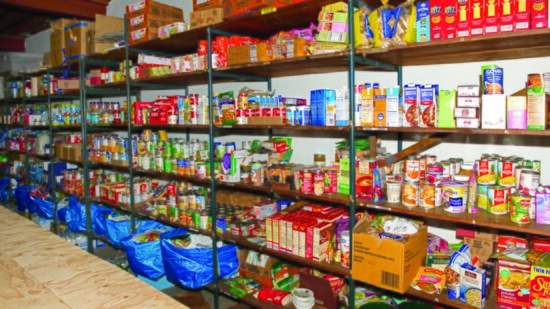“I bet you’re looking for me.”
I spun around. I had been meandering aimlessly around the warehouse on Naugatuck Avenue searching for the right entrance. It was a cold and windy October afternoon, and I had opted to leave my coat in the car. I couldn’t wait to get inside.
When I turned around, I saw a woman shuffling toward me from the back of the warehouse. She was carrying two extra large bags overflowing with groceries. As she approached, I noticed a single streak of hair dangling down in front of her glasses, dyed purple.
Susan Brown, the founder of Purple Pantry Boxes, was a public defender for most of her professional life. In this role, she learned how prominent food insecurity was among her clients and the broader community. “Pay the court fees, or feed your family – that was the decision many people faced,” she explained to me that afternoon. We were standing on opposite sides of a giant wooden table, surrounded by wall-to-wall shelves of packaged food and the comforting smell of fresh bread. The space occupied a small enclave of a broader warehouse equipped with electricity, but no heating. I shivered. Sue stood in front of me in a purple sweatshirt, hands in the front pocket, unbothered by the cold.
“We began with plastic bins,” she told me. She had left large plastic storage bins full of food around town, equipped with signs asking people to kindly leave the bins behind so she could refill them. “But of course, the bins disappeared,” she laughed. She and her small team of like-minded good samaritans decided they needed a more permanent solution. A neighbor offered to construct a wooden box, one sturdy enough to withstand the elements and keep food safe.
“We had no permission, we just did it,” Sue recalled. “Someone on my street was a retired public works person, so he helped me brainstorm places to put the pantries. The day after we did it, I got an admonishing phone call from the authorities. They threatened to remove the pantries, but then they heard about how much people loved them.”
Now, there are 18 Purple Pantry Boxes in southern Connecticut, 13 of which can be found in Milford. The team is made up entirely of volunteers, some of whom have been with the organization for more than three years. While Sue is the primary organizer of the operation, volunteers fulfill roles like grocery shopping, grocery pickup (from partnering retailers that donate food regularly), organizing shelves in the warehouse, arranging delivery bags, and of course, filling the pantries.
“When someone reaches out to volunteer, I always meet them face to face. I want them to know what kind of space they’ll be working in. If you can handle this” – and here Sue gestured around, acknowledging the organized but scrappy workspace – “I would never say no to a volunteer.”
Why purple? The answer is simple: Sue’s favorite color. For every pantry, Sue has a checklist: each filling requires five different forms of protein. All food is shelf-stable and factory-sealed. Foods that lack nutritional value are decidedly limited, and nothing goes into a pantry if the ingredients are not clearly listed on the label.
As we walked around the warehouse, Sue led me into a larger, completely empty room. “This is going to be our new, additional space,” she explained. “We’re so excited. We’ll be able to bring in refrigerators and freezers to start storing perishables for home deliveries.” A few short weeks later, she was able to purchase a commercial refrigerator at an auction in New Haven.
When I asked if there was a message she would like to relay to the Milford community, Sue had two to share: “First, I’d like to say thank you. The community has been so incredibly supportive. And second, what people need to understand is that food insecurity is hidden – you can live in a house, you can drive a car, and you can not have enough money for groceries. Normal everyday things that happen in life can throw someone’s budget completely out of whack."
Sue explained that the often-overlooked piece of food insecurity is that food must have nutritional value. Even those who can purchase food regularly may experience food insecurity if the only food they can afford to buy fails to meet their family's needs.
As we closed our conversation, I noted how unique Purple Pantry Boxes are for providing food to the community with no strings attached. Sue shrugged, but her expression turned severe as she said, “I’m not going to make anyone prove to me that they need food. I truly believe that food is a right, not a privilege. Take what you need."
Learn more at purplepantryboxes.com.
"Pay the court fees, or feed your family – that was the decision many people faced."
"Food insecurity is hidden – you can live in a house, you can drive a car, and you can not have enough money for groceries."
